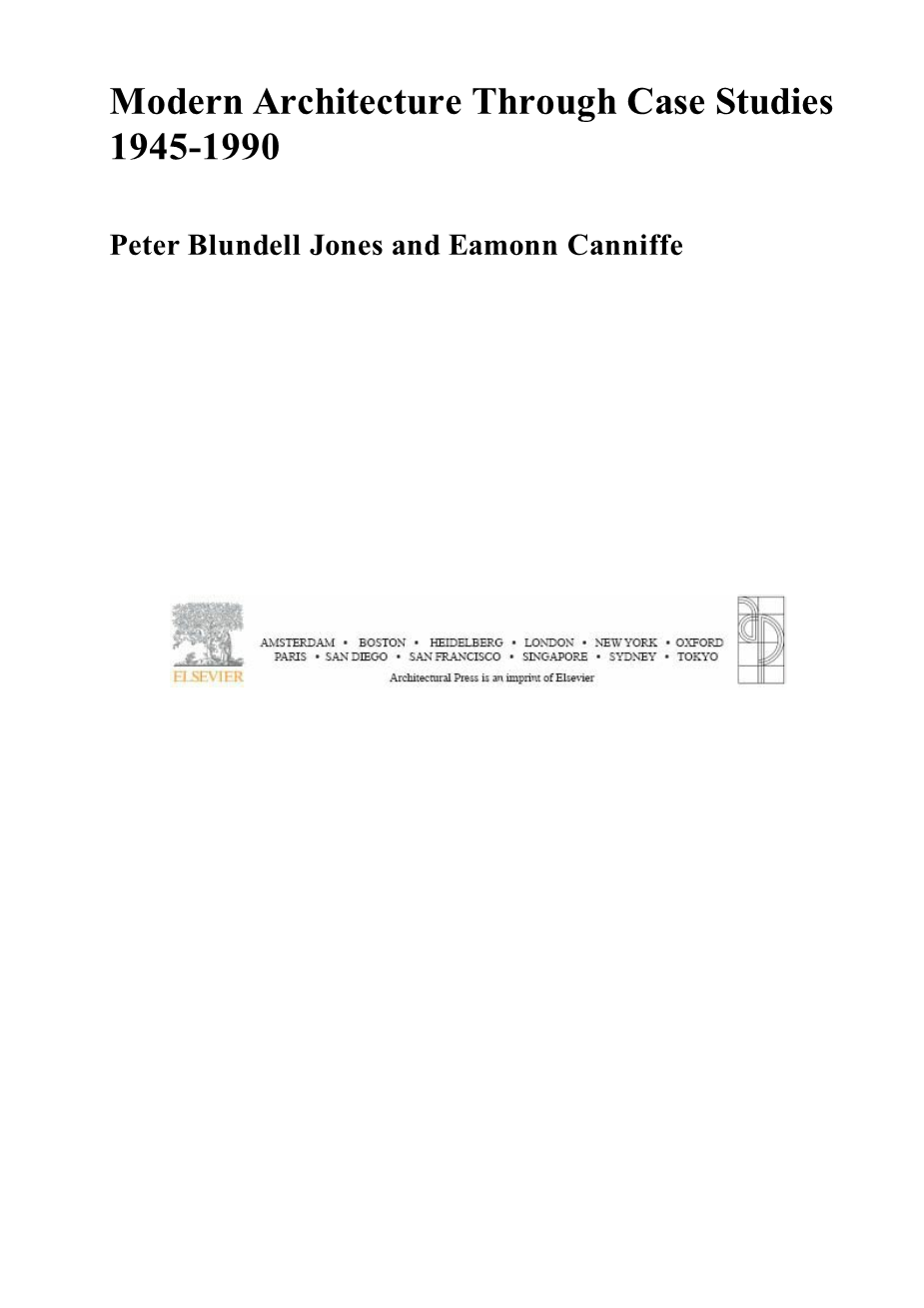

英语原文共 8 页,剩余内容已隐藏,支付完成后下载完整资料
现代建筑的个案研究
1945-1990
彼得·布隆德尔·琼斯和埃蒙·坎尼菲
hellip;hellip;在太平洋进行了激烈的战争,在战时拘留了日裔美国人之后。建筑师们沉默而谨慎,对经济手段的强调表现出一种无争议而严肃的态度。这些日裔所带来的影响在房子的黑白照片中尤为明显,但在现实中人们偏爱于对色彩的运用,特别是用明亮的原色粉饰的实心面板。这一方面与过去二三十年的欧洲现代主义有着截然不同的联系,特别是荷兰风格派。雷·伊姆斯婚前在纽约参加美国抽象艺术家运动时遇到了蒙德里安,其房子的结构与色彩的并置与蒙德里安的绘画有许多相似之处,但空间态度是不同的。正如里特维尔德的红蓝椅和施罗德住宅所证明的那样,对以前封闭形式的动态态度是荷兰风格派的核心理念。相反,一定程度的静止代表着伊姆斯的美学观念,这主要体现在框架结构的刚性和彩色面板的持久性上。 虽然时不时想要改变它们,但原来的配色方案保持不变。变化是通过日常和季节性节奏来实现的。
图8 工作室里展现着简洁的钢结构,小尺度的楼梯和伊姆斯设计的家具。
图9 从草地对面看房子,房子前种着一排桉树。
与后来的一些案例研究有所不同,这栋建筑内部的空间体验不是扩张性的。双层高度空间的开放性反而促进了视觉和材料的复杂性,因为空间及其表面从一开始就充满了折中主义的艺术品和家具,这一决定与早期现代主义房屋的设计统一性相矛盾。欧洲前卫派的严肃的高尚思想也没有反映在伊姆斯住宅向其商业受众的轻率推广上。除了1950年9月在建筑论坛上以“中国风筝中的生活”为标题出版这所房子外,伊姆斯夫妇还在1950年至1952年期间为赫曼·米勒公司设计的存储单元中复制了房子的框架和面板语言,使任何房主都能以负担得起的价格分享伊姆斯的经验。这所房子也是1954年4月Vogue时装拍摄的背景,1951年,伊姆斯工作室制作了“玩具”,这是一套色彩鲜艳的三角形面板,可以组装成四面体结构和儿童游戏空间。1952年又制作了较小的版本。 1959年,伊姆斯住宅的小规模复制品被出售为利华公司的玩具屋,其尺寸为英尺(1:16),并配有伊姆斯住宅的家具模型。
图10 住宅和工作室的立面采用蒙德里安式的构图。
Modern Architecture Through Case Studies
1945-1990
Peter Blundell Jones and Eamonn Canniffe
bitterly fought war in the Pacific, and after wartime internment of Japanese Americans. The architects were reticent, preferring a non-controversial no-nonsense emphasis on economy of means. The lsquo;Japanesersquo; effect was particularly evident in black and white photographs of the house, but in actuality colour was preferred, especially with solid panels painted in strong primary colours. This aspect brought quite different associations with European modernism of the previous two or three decades, especially Dutch De Stijl. Ray Eames had met Piet Mondrian while part of the American Abstract Artists movement in New York before her marriage, and some similarity with his paintings can be recognised in the housersquo;s juxtapositions of frame and colour, but the spatial attitude is different. As demonstrated in Rietveldrsquo;s Red-Blue Chair and Schrouml;der House, a dynamic attitude to previously closed forms was central to De Stijl. In contrast, a degree of stasis characterised the Eames aesthetic, dominated by the rigid nature of the frame and the permanence of the coloured panels. Although there had been an intention to change them from time to time, the original colour scheme was maintained intact. Changefulness was achieved instead through daily and seasonal rhythms.
8. Studio with simple steel structure, minimal staircase and Eames-designed furniture.
9. View of the house from across the meadow with the line of eucalyptus trees in front.
Unlike some of the later Case Study houses, the spatial experience of the interior was not one of expansiveness. The openness of the double height space encouraged instead a sense of visual and material complexity, as the space and its surfaces were filled from the start with an eclectic range of artefacts and furniture, a decision at odds with the designed uniformity of earlier modernist houses. Nor was the austere high-mindedness of the European avant-garde reflected in the ludic promotion of the Eames House to its commercial audience. Besides publishing the house in Architectural Forum in September 1950 under the headline lsquo;Life in a Chinese Kitersquo;, the Eameses reproduced the housersquo;s language of frame and panel in storage units which they designed for the Hermann Miller company between 1950 and 1952, enabling any home owner to share in the Eames experience at an affordable rate. The house also featured as the backdrop of a fashion shoot for Vogue in April 1954, and in 1951 the Eames Studio produced lsquo;The Toyrsquo;, a set of brightly coloured triangular panels which could be assembled to create tetrahedral structures and childrenrsquo;s play spaces. A smaller version was produced in 1952. In 1959, small-scale reproductions of the Eames House were sold as the Revell Companyrsquo;s Toy House at three-quarter inch to the foot scale (1:16), furnished with model Eames furniture.
10. House and studio facades with Mondrian-like composition.
11. End of the house, which sits on a retaining wall to left.
Experience of the house as built was communicated to a wider public unable to visit it through the film House: After Five Years of Living, a ten-minute short consisting of still images of house and contents in saturated colour. This was the classic format of the Eames films, akin to a controlled slideshow (in this instance with a score by the film composer Elmer Bernstein) which allowed concentration on the abstract compositional values of light and shade, colour, modern machined elements and folk art. This formal method underscored the importance of the housersquo;s frame in organising disparate elements into a coherent whole.
An apolitical stance?
The Eameses claimed, like other modernist protagonists, to have preserved a professional detachment from politics, and that the personal genius demonstrated in their films at the American National Exhibition in Moscow of 1959, for example, was without lsquo;officialrsquo; approval. This suggests the naivety of the closeted designer pursuing a personal vision irrespective of what might be inferred by others. The same supposed detachment accompanied the critical reception of abstract expressionism, which was portrayed both as quintessentially American and as apolitical: as evidence of individual genius which American society prized. But despite its apparent self-sufficiency, the Eames House cannot be removed from its political context. Conceived as a prototype for a new way of dwelling, it became instead, through propagation of its image, a subtle tool of the Cold War period. The laudatory nature of the Eamesesrsquo; benign view of Americana led from a contract with the military during the Second World War through government commissions like the film and exhibition work in Moscow of 1959 (the scene of the lsquo;kitchen debatersquo; between Nikita Khrushchev and Richard Nixon) to the of
剩余内容已隐藏,支付完成后下载完整资料
资料编号:[239346],资料为PDF文档或Word文档,PDF文档可免费转换为Word


